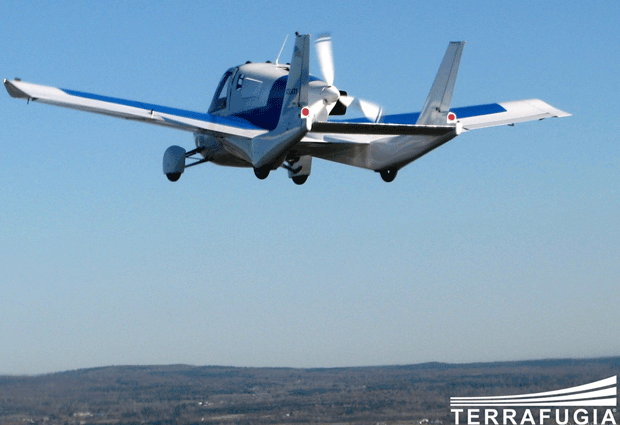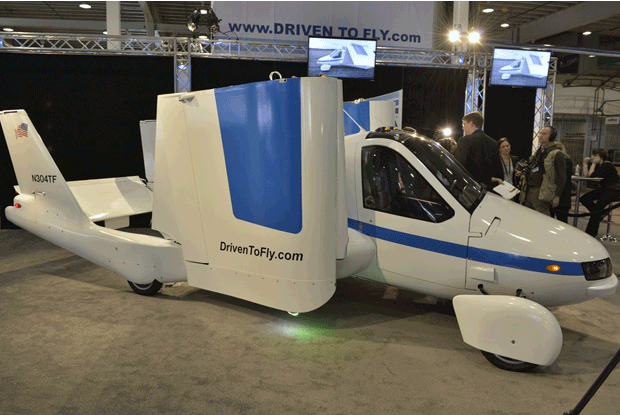|
It seems like something out of The Jetsons, but it's
real. Or at least it will be soon.
Terrafugia is perhaps just a few regulations and one very powerful
battery away from clearing most of the hurdles it needs to create a
flying car that consumers in the market for the equivalent of a super
luxury sedan could afford.
It's a dream that Carl Dietrich, the company's co-founder, CEO and CTO,
has been working at steadily since at least 2006.
|
|
 |
|
"I think it's ridiculous we don't have these things out there, right
now," Dietrich said, speaking of the flying cars he's helping to design.
"There is so much potential for an economic benefit to society if we
have things like this. There have been a number of studies recently that
have quantified the economic impact of traffic congestion ... just for
the U.S., I think it was estimated at $87 billion to $125 billion a
year. And that's just comparing it to driving at normal speeds, without
traffic."
So, that's part of the reason why Dietrich and Terrafugia want your car
to take wing, but it's also been part of his lifelong passion for
flight. Even at a young age, Dietrich wondered why small aircraft
weren't developing toward a more practical, everyday transportation
option.
It was in 2004, while he was completing his Ph.D. at M.I.T., that
Dietrich read about new developments at the Federal Aviation
Administration — new kinds of pilots' licenses and a new kind of
aircraft certification. These paved the way for Terrafugia. Enter the
Transition.
The Transition: Prototype for the Terrafugia
Vision |
|

|
|
With a cruising speed of 100 miles per hour in the air and gas mileage
of about 35 to the gallon on the ground, Terrafugia's first model of
flying car exists already.
"We're flying a second-generation prototype, right now," Dietrich said
of the Transition. "But yes, it's beyond the proof of concept stage."
The Transition is basically a small general-aviation airplane that can
fold up its wings with the push of a button. It runs on normal
automative gasoline — about 30% less expensive than aviation fuel (its
range is about 410 miles plus a 30-minute reserve). Fly the Transition
to a small airport, land, and the wings withdraw in less than a minute.
Its propeller disengages and its rear-wheel drive turns on. At that
point, you're street legal and ready to roll. At home, the Transition is
designed to fit within a single-car garage.
"One of the biggest problems that pilots face is that flying little
airplanes is a very weather-sensitive activity," said Dietrich. "You may
fly somewhere, and the weather changes and you're stuck. You have to
make other travel arrangements. It's not something you can count on.
With the Transition, you can count on getting to where you want to go.
It may take a little longer, if you have to drive instead of fly, but
you still get there, or you get home." |
|

|
|
But only if you have a pilot's license, because this is still considered
a plane and not a car or something in between. And the price of a
Transition? When it comes to market, it'll likely cost about $279,000,
putting it in the range of consumers who'd buy, say, a super sports car,
something of that nature.
The next generation from Terrafugia, the follow-up to the Transition,
should prove a bit more universally affordable.
TF-X: Next Steps into the Air
When we think about flying cars, we're probably wishing for something
more like what science fiction has suggested would be that key imagined
value prop — that in the middle of snarled traffic we could just lift
into the air and soar away. Well, that's not quite what Terrafugia
promises in its next flying-car iteration, but it's close.
"How cool and useful could we make a flying car, just based on the
physical limitations and the state of technology?" said Dietrich.
"That's what TF-X is, it's what we believe we can do."
|
|
 |
|
In its design phase, TF-X is a vertical take-off and landing vehicle,
equipped with computers and a network that provides a great deal of
automated navigation and piloting. All the stick-and-rudder work of the
conventional pilot (and even that of the Transition)? Gone. The operator
in the TF-X would have the primary task of confirming that the trip is
proceeding safely. Everything is done for them. Five hours of training
and then you're on your way. No pilot's license required.
And instead of a runway — the Transition needs about 1,700 feet for
takeoff — you'd be able to utilize pre-approved zones in places such as
parking lots and open fields. Since TF-X takes off and lands straight up
and down, there's no runway at all.
Furthermore, TF-X would be at least a hybrid vehicle. Dietrich says
Terrafugia is counting on advancements in battery technology —
much-needed increases in endurance are expected in the coming decade. If
the vehicle could run on battery for hours rather than about 10 minutes,
it'd likely be good-bye to the combustion component of the TF-X
altogether.
|
|
 |
|
And, unlike the Transition, you won't need a quarter million to get into
the operator's seat. Dietrich said the TF-X, produced at a high enough
volume, could retail in the mid-five-figure range — about what you'd pay
for a Tesla Model S.
Clearing the Hurdles
Beyond better batteries for the TF-X, the main challenge that Terrafugia
faces is that of regulations. Before we can all take to the air in our
computer-assisted craft, the FAA and other agencies have to sign off on
the prospect of all these vehicles zipping through the sky.
The Transition is already in good shape, or so it seems. According to
Dietrich, the National Highway Traffic Safety Administration has already
granted Transition the needed special considerations. Now, Terrafugia is
waiting on the FAA to make its determination about a special weight
allowance.
As for the TF-X, it's a bit more complicated. The present iteration of a
battery and motor combo will need special approvals — not to mention the
regulations that will have to be addressed around landing zones and the
systems that would make TF-X a mostly computer-assisted experience. But
Terrafugia is working on those things, becoming a part of the panels and
boards that will make the next generation of rules that the concept of
flying cars will need in place to survive.
"We are having an influence on the emerging regulatory standards that
will be used as basis for certification of future products," said
Dietrich. "We can actually see a pathway to effect the change that will
need to happen to make cars like TF-X actually work." |
|
VIEW PICTURE GALLERY
|
|
|
| |
|
|